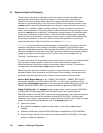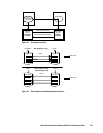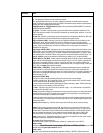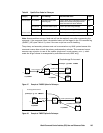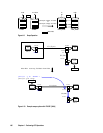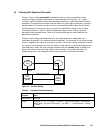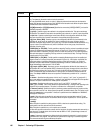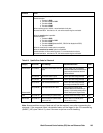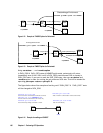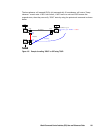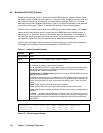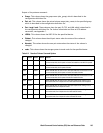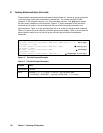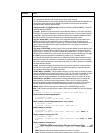
188 Chapter 4 Performing CCI Operations
Parameter Value
Options -h: Displays Help/Usage and version information.
-q: Terminates the interactive mode and exits this command.
-z or -zx (OpenVMS cannot use the -zx option): Makes the pairevtwait command enter the interactive
mode. The -zx option guards performing of the HORCM in the interactive mode. When this option detects
a HORCM shut down, interactive mode terminates.
-I[H][M][instance#] or -I[TC][SI][instance#] Specifies the command as [HORC]/[HOMRCF], and used for
specifying instance# of HORCM.
-g <group>: Specifies a group name defined in the configuration definition file. This option must always
be specified. The command is executed for the specified group unless the -d <pair Vol> option is specified.
-d <pair Vol>: Specifies a paired logical volume name defined in the configuration definition file. When
this option is specified, the command is executed for the specified paired logical volumes.
-d[g] <raw_device> [MU#]: Searches a group on the configuration definition file (local instance) for the
specified raw_device, and if the specified raw_device is contained in the group, the target volume is
executed as the paired logical volume (-d) or group (-dg). This option is effective without specification of “-g
<group>“ option. If the specified the raw_device is contained in two or more groups, the command is
executed on the first group.
-FHORC [MU#] or -FCA [MU#]: Forcibly specifies a cascading TrueCopy volume for specified pair logical
volumes on ShadowImage environment (see example in Figure 4.12). If the -l
option is specified, this
option tests status of a cascading TrueCopy volume on a local host (near site). If no -l option is specified,
this option tests status of a cascading TrueCopy volume on a remote host (far site). The target TrueCopy
volume must be P-VOL or SMPL.
-FMRCF [MU#] or -FBC [MU#]: Forcibly specifies a cascading ShadowImage volume for specified pair
logical volumes on TrueCopy environment (see example in Figure 4.13). If the -l option is specified, this
option tests status of a cascading ShadowImage volume on a local host (near site). If no -l option is
specified, this option tests status of a cascading ShadowImage volume on a remote host (far site). The
target ShadowImage volume must be P-VOL or SMPL.
-d[g] <seq#> <LDEV#> [MU#]: Searches a group on the configuration definition file (local instance) for
the specified LDEV, and if the specified LDEV is contained in the group, the target volume is executed as
the paired logical volume (-d) or group (-dg). This option is effective without specification of “-g <group>“
option. If the specified LDEV is contained in two or more groups, the command is executed on the first
group. The <seq #> <LDEV #> values can be specified in hexadecimal (by addition of “0x “) or decimal
notation.
-s <status>: ..Specifies the waiting status, which is “smpl”, “copy/rcpy”, “pair”, “psus”, or “psue/pdub”. If
two or more statuses are specified following -s, waiting is done according to the logical OR of the specified
statuses. This option is valid when the -nowait option is not specified.
-ss <status>: Specifies the waiting status, which is “smpl”, “copy”(“RCPY” is included), “pair”,
“ssus”,”psue” on SVOL. If two or more statuses are specified following -s, waiting is done according to the
logical OR of the specified statuses. This option is valid when the -nowait option is not specified.
-t <timeout> [interval]: Specifies the interval of monitoring a status specified using the -s option and the
time-out period in units of 1 sec. Unless [interval] is specified, the default value is used. This option is valid
when the -nowait option is not specified. If <timeout> is specified more than 1999999, then “WARNING”
message will be displayed.
-nowait: When this option is specified, the pair status at that time is reported without waiting. The pair
status is set as a returned value for this command. When this option is specified, the -t and -s options are
not needed.
-nowait[s]
When this option is specified, the pairing status on SVOL at that time is reported without waiting. The
pairing status is set as a returned value for this command.
When this option is specified, the -t and -s options are not needed.
-l: When this command cannot utilize a remote host for host down, this option executes this command by a
local host only. The target volume of a local host must be SMPL or P-VOL. (ShadowImage volumes are
able to specify from SVOL.)
-nomsg: Suppresses messages to be displayed when this command is executed. It is used to execute a
command from a user program. This option must be specified at the beginning of a command argument.
The command execution log is not affected by this option.



